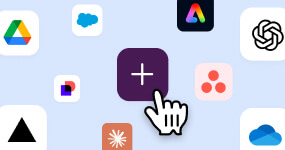The way we work has undergone radical and rapid changes. It wasn’t long ago that teams relied on paper filing and manual entry. Then came instant messaging and cloud software to help people work from anywhere. Now, autonomous agents and automated workflows handle tasks across tools, departments, and time zones.
This shift has introduced a new kind of teammate. The digital workforce is here, and it’s changing how work gets done.
Find out how a digital workforce works, how it can help teams be more efficient, and what it means for the future of business.
What is a digital workforce?
A digital workforce is a set of automated systems, including AI agents, software bots, chatbots, and virtual assistants, that can be programmed to perform routine or time-consuming tasks. The goal is to free up humans to handle work that’s more complex, creative, and relationship-driven. Digital workforce systems can automatically respond to requests, manage workflows, and process data.
Unlike traditional automation, which relies on preset scripts, digital workers equipped with agentic AI can adapt to real-time input, pull information from integrated tools, and assist teams across departments. The digital workforce includes technologies such as artificial intelligence, natural language processing, machine learning, and robotic process automation.
Organizations rely on digital workforces to strengthen remote collaboration and keep up with rising workloads. These systems support 24/7 operations and help human teams focus on tasks that need their judgment and creativity.
Benefits of implementing a digital workforce
Digital systems take action as soon as conditions are met, which reduces delays between steps, cuts down on manual coordination, and keeps work from piling up in a bottleneck. The time and effort saved by a streamlined flow can add up to serious gains.
In a recent study, 36% of organizations reported significant cost savings after implementing digital workplace tools. These improvements come from automating processes like account provisioning, expense tracking, and report generation.
Maybe the best benefit of all? When digital systems handle structured tasks, human teams can shift their focus to more impactful tasks that involve strategy or customer relationships. The reallocation not only can improve output and results but can also increase job satisfaction.
Key features of an effective digital workforce
Before investing in a digital HQ, consider your needs and identify the features that best match them. Every company is different, but these are the features every effective digital workforce should have:
- Integration with daily tools: Connects to platforms like Slack and Salesforce to move data, trigger actions, and respond in real time
- Scalability and flexibility: Deploys quickly to meet changing demands without requiring an increase in headcount.
- Ease of use: Supports natural language and basic click, drag, and drop functions — no coding experience needed
- Real-time responsiveness: Acts instantly upon a change or request
- Visibility: Shows activity through logs, alerts, and messages so teams stay informed
- Security and compliance: Protects data, honors permissions, and maintains audit trails
- Adaptability: Updates workflows easily with low-code tools or admin settings
Real-world applications of a digital workforce
The potential uses of agentic AI and a digital workforce are unlimited in businesses across a variety of industries. Here are some of the areas where they’re making a difference.
Process automation
One of the most common uses of a digital workforce is to automate tasks and simplify information sharing. Think of actions you do that don’t require much judgment but eat up time to do them manually. For example: scheduling a meeting. AI tools can scan multiple calendars to find an open time — and then also record the meeting, create a summary of the meeting, and generate task lists for after the meeting.
If you’re a Slack user, you can automate processes using Slack’s AI assistants. Switching from app to app takes time, especially if you can’t easily find what you need. AI agents can help you bring it all into one place.
- Syncing your project tracking system can keep you updated on statuses and next steps with automatic reminders.
- Connect content apps to bring their automations into Slack, such as generating AI text or pulling up your branded images on command.
- Integrate your IT and HR platforms, and you can automate password resets and time-off approvals without diverting someone from their work.
A digital workforce allows machines to take care of the details of managing information so you can get what you need to keep moving.
AI-driven data analysis
Delegating to a digital workforce can add incredible value by helping teams gather, review, and interpret information faster. Instead of digging through threads, files, and tools to find answers, you can use AI systems to surface key details, often with natural language prompts.
With machine learning, AI can even be trained to identify patterns in large amounts of data that would take humans a much longer time to analyze. Tools may also be programmed with predictive AI to provide insights about the data and suggest recommendations so that teams can make better-informed decisions in much less time.
For example, a retail clothing shop might have its marketing team use a digital workforce to do the research work for email campaigns. The AI system could collect data, such as open rates and conversions, and then identify high-value customer segments where emails have been successful. The marketing team would use this info to plot the next approach and then set the digital workforce to task again, gathering research on how the latest emails perform.
Customer support enhancements
In customer service, requests often follow a predictable pattern, and quick response times and accurate answers are critical. AI agents and automations can take the pressure off customer service reps by handling low-level routine support requests and escalating issues that need a human touch.
Systems with AI agents can also be an at-the-ready assistant for reps. For example, Salesforce’s internal IT support team, Techforce, built an Agentforce agent deployed in Slack. The agent instantly answers common questions, automates routine tasks, and escalates complex problems to humans when needed. Since launch, it has handled 64,000 conversations, serves 28,000 employees, and resolves 35% of issues without human intervention — saving 16,800 hours annually. Built on Service Cloud and optimized with a curated 600-article knowledge base, the agent provides personalized, conversational support in Slack and continues to evolve toward even greater automation and smarter responses.
Digital workforce challenges and considerations
Implementing a digital workforce also comes with challenges, especially for organizations that are still scaling their technology. Some common hurdles include:
- Resistance to change: Some teams need time to adjust to working alongside digital agents.
- Legacy systems: Older tools may not integrate easily, often requiring a phased rollout.
- Limited resources: Not every team is ready to automate at scale; starting small can help build momentum.
- Privacy and compliance: Automation must protect sensitive data and follow strict security standards.
To stay secure while scaling automation, many teams rely on tools that offer admin-level control, centralized management, and enterprise-grade data protection. Slack’s AI tools and Agentforce, for instance, are designed with these requirements in mind, giving IT and compliance teams the visibility they need without slowing down productivity.
The future of the digital workforce
Advances in AI will keep pushing the tech to take on more tasks, helping teams to achieve more with less manual work. Digital workforces will keep developing and improving as collaborators.
To unlock the full potential of these technologies, organizations will need a digital-first mindset and tools that can both integrate with the systems you have in place and grow with your needs.
A work operating system like Slack can help you scale up a digital workforce in your organization. Learn how to get started with Agentforce in Slack or explore Slack solutions and find out why it’s where work happens.






